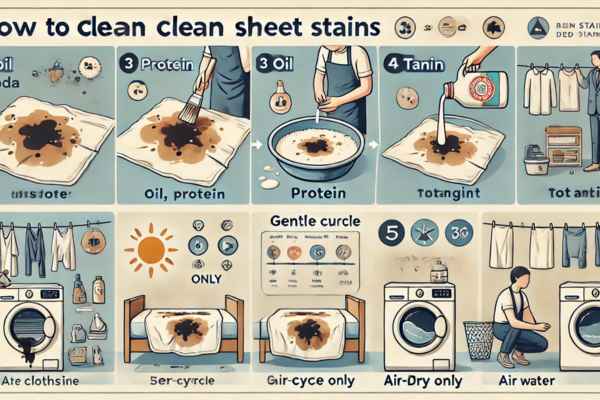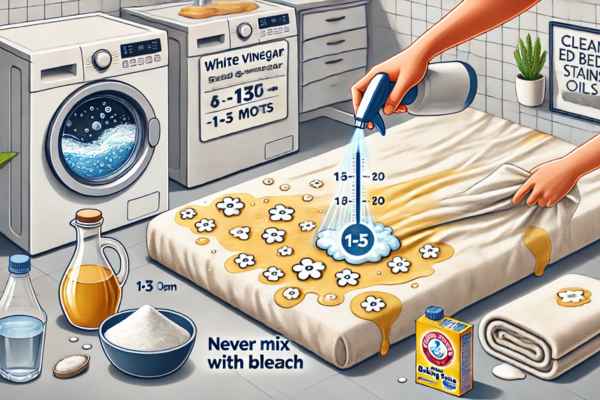There’s nothing quite like slipping into a freshly made bed. The soft embrace of clean sheets can soothe even the most restless of minds. But when those sheets bear unsightly stains—whether from sweat, blood, or last night’s wine—it disrupts both comfort and peace of mind. Learning how to clean bed sheet stains isn’t just about aesthetics; it’s about hygiene, fabric preservation, and peace of sleep. Whether you’re dealing with set-in spots or fresh spills, mastering the basics can save your linens and your sanity.
Understanding Why Bed Sheets Get Stained So Easily
Your bed sheets are exposed to more than you think. Natural body oils, perspiration, makeup residues, food crumbs, and even environmental dust all settle into the fabric. Over time, this creates a mosaic of discoloration that regular washing can’t always erase. Factors like fabric type, thread count, and exposure to moisture accelerate stain absorption. Moreover, certain lifestyle habits—like snacking in bed or sleeping without showering—can amplify the issue.
Essential Tools and Supplies for Cleaning Bed Sheet Stains
To wage war against stubborn stains, arm yourself with the right tools. At the bare minimum, you’ll need a quality detergent, a gentle but effective stain remover, white vinegar, baking soda, an old toothbrush, and hydrogen peroxide. Microfiber cloths and a spray bottle also come in handy. For natural solutions, lemon juice and salt can do wonders. Investing in enzyme-based cleaners may feel excessive, but they’re powerful allies, especially for protein-based stains.
How to Clean Bed Sheet Stains the Right Way (Step-by-Step)

- Identify the stain – Determine its origin: oil-based, protein-based, or tannin-based.
- Pre-treat promptly – Apply your stain remover or a DIY mix (like baking soda paste) before the stain sets.
- Soak if needed – Let the sheet sit in a warm water and detergent mix for at least 30 minutes.
- Wash with the right settings – Use the hottest water safe for your fabric type and a gentle cycle.
- Air-dry first – Never tumble dry until the stain is gone; heat sets it permanently.
How to Clean Bed Sheet Stains from Sweat and Body Oils

Sweat and sebum stains often appear as yellowish patches, especially on light-colored linens. Mix equal parts of white vinegar and water in a spray bottle, spritz the affected area, and let it sit for 15–20 minutes. Follow with a baking soda scrub before washing. For persistent marks, add a splash of ammonia (never mix with bleach) to your detergent to boost oil breakdown.
How to Clean Bed Sheet Stains Caused by Blood

Blood stains demand swift action. Rinse the spot under cold water—hot water will set the protein. Dab (don’t rub) with hydrogen peroxide or a saltwater solution. For dried stains, create a paste with baking soda and water, apply it, and let it rest for 30 minutes before rinsing and laundering.
How to Clean Bed Sheet Stains from Urine
Urine stains can leave both a mark and a strong odor. Blot excess liquid, then saturate the area with a vinegar solution (1 part vinegar, 2 parts water). Let it sit for 15 minutes, then sprinkle baking soda on top. This dual-action approach neutralizes odor and lifts the stain. Use enzyme cleaners for accidents from pets or young children.
How to Clean Bed Sheet Stains from Food and Drinks
Coffee, wine, and greasy snacks often leave the most stubborn reminders. Blot liquids immediately with a dry towel. For wine, pour salt over the spill to absorb moisture. For grease, apply dish soap directly to the stain and rub gently. Rinse and launder as usual, repeating if necessary.
How to Clean Bed Sheet Stains from Makeup and Skincare Products
Cosmetics like foundation and lipstick cling to fibers. Dab a small amount of rubbing alcohol or micellar water onto the stain. For oil-based skincare products, use dish detergent to cut through the residue. Let it sit for 15 minutes before washing. Avoid bleach, as it can worsen discoloration on dyed sheets.
How to Clean Bed Sheet Stains from Pet Accidents
Accidents from furry friends require extra care. Blot the area, then use a pet-safe enzyme cleaner to break down the stain at the molecular level. Vinegar and baking soda can also be effective alternatives. Always rinse thoroughly and avoid products with artificial fragrances that can irritate pets’ noses.
How to Clean Bed Sheet Stains Using Natural Remedies
Nature has powerful stain-fighting tools. Lemon juice acts as a mild bleach for sun-drying. Baking soda neutralizes odors while scrubbing away grime. A combination of hydrogen peroxide and dish soap creates an effective DIY stain solution. Use these sparingly on delicate fabrics and always test a small area first.
When to Use Commercial Stain Removers and Which Ones to Trust
Sometimes, natural remedies aren’t enough. Commercial products like OxiClean, Zout, or Shout are formulated for deep stain removal. Choose options labeled for delicate fabrics and free of phosphates. Read labels carefully and avoid bleach unless your sheets are pure white and bleach-safe.
How to Keep Bed Sheets Stain-Free Going Forward
An ounce of prevention is worth a pound of detergent. Shower before bed to reduce body oils, avoid eating under the covers, and remove makeup at night. Use pillow and mattress protectors to create additional barriers. Rotating your sheets weekly also reduces wear and discoloration.
How Often Should You Wash and Inspect Your Bed Sheets?
Wash your sheets every 7–10 days. In warmer months or if you sweat more, consider washing them weekly. Inspect them for early signs of staining—especially on pillowcases and foot zones—and treat these areas immediately to avoid permanent discoloration.
How to Store Bed Sheets Properly to Prevent Future Stains
Store clean, completely dry sheets in a cool, dry place. Avoid plastic containers that trap moisture—opt for cotton storage bags instead. Tuck in lavender sachets to ward off insects and keep linens fresh. Never store sheets with lingering stains; time sets them deeper into the fibers.
Conclusion
Knowing how to clean bed sheet stains empowers you to extend the life of your linens, enhance your sleep environment, and save money. Whether tackling stubborn blotches or aiming for preventive care, the right techniques turn frustration into satisfaction. With a little effort and the right routine, your bed can remain the restful haven it’s meant to be—crisp, clean, and truly comforting.
